HP Phoenix h9se: The Pavilion Goes Beyond Thunderdome
by Dustin Sklavos on February 29, 2012 12:00 AM ESTSystem Performance
The HP Phoenix h9se we have for review presents us with a rare opportunity: we have a gaming desktop configured entirely at stock speeds. Also keep in mind that the GTX 580 we have in our system is no longer being offered, as it is being replaced by the AMD Radeon HD 7950 at an ever-so-slightly lower price point, so you'll be getting the same or better performance for about the same amount of money.
We also have a special guest in our charts; the unit marked "Unknown Sample" is a custom rig from a boutique that isn't yet available. We had intended to post that review first, but we've been asked to hold that for a couple more weeks, so we'll just let the numbers speak for themselves.


The SSD used in the HP Phoenix is an Intel 320, which is unfortunately limited to 3Gbps operation. As a result our PCMark charts skew heavily in favor of other machines that use faster SSDs. The Intel 320 is by no means awful (an SSD of virtually any stripe is still a notable upgrade as a system drive), but it's a generation behind in terms of performance.
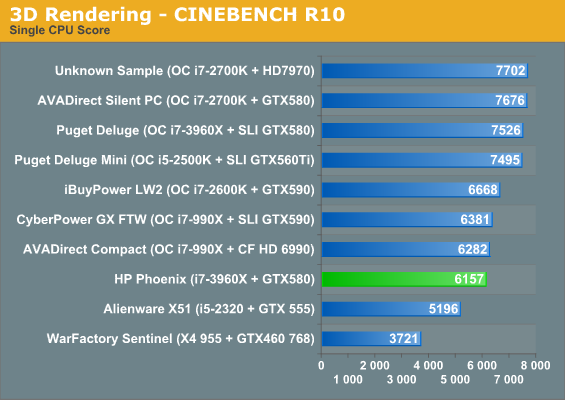

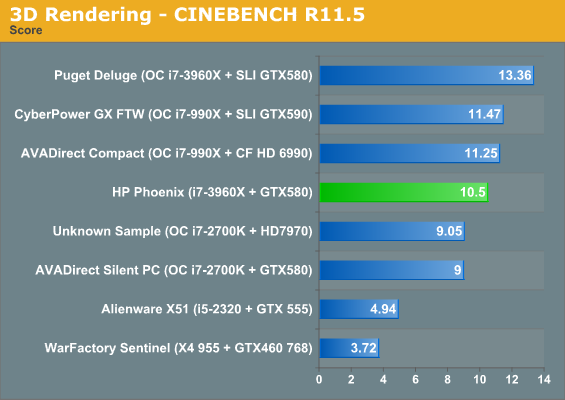
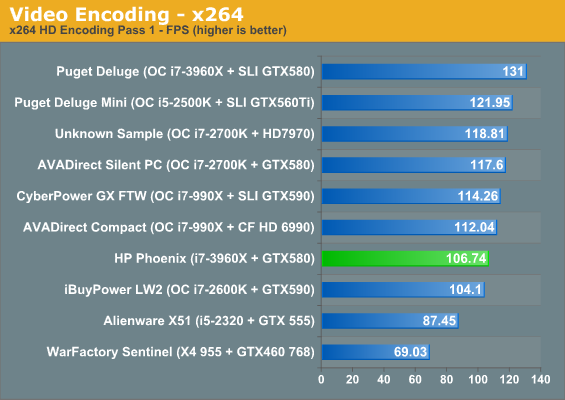
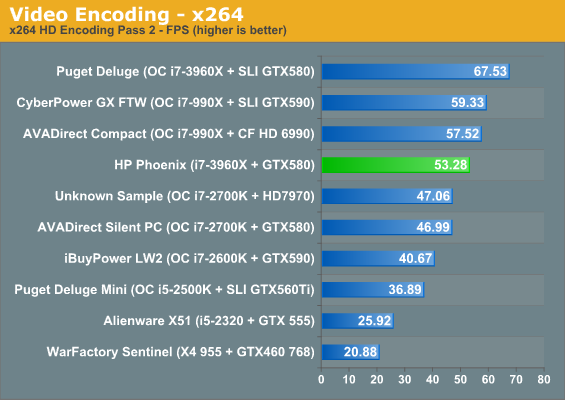
It's interesting to see how a stock-clocked i7-3960X is able to line up against heavily overclocked Sandy Bridge quad-cores (not to mention the previous generation's i7-990X). Every overclocked processor on these charts is running in excess of 4GHz, while the 3960X has to make do with only being able to turbo up to 3.6GHz on all six cores. When it can't leverage the extra two cores, the 3960X carries a notable deficit behind the heavily overclocked Sandy Bridge chips, but once those two come into play, the stock-clocked 3960X is able to mostly hang with the 4GHz+ i7-990X chips and blows past the quads.
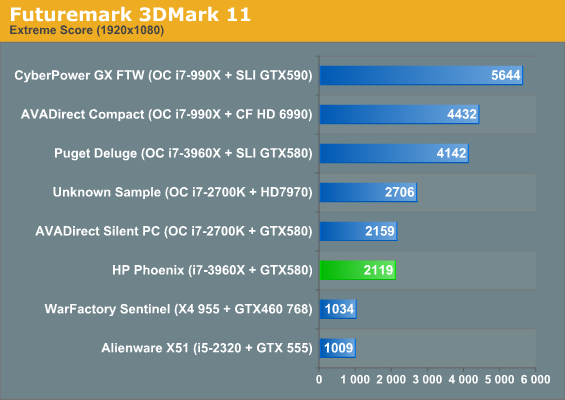

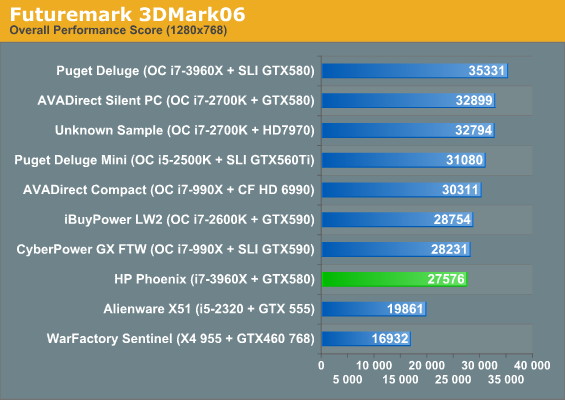
By this point the GeForce GTX 580 is a well-known quantity. A single-GPU card isn't going to be able to compete with dual- and quad-GPU solutions, but it remains among the fastest single-GPU cards available. Unless you're running multiple monitors, the GTX 580 remains very capable, and once the 7950 becomes available for HP things should get shaken up a bit more.










39 Comments
View All Comments
Flunk - Wednesday, February 29, 2012 - link
I'm not a big fan of the look of the case but the support for high-end graphics cards makes this a much more viable system than the Alienware X51. This could be a good option for gamers who don't build their own systems and don't want to pay the boutique prices.cknobman - Wednesday, February 29, 2012 - link
A. This thing is UGLY AS PHUCKB. Note: Custom motherboard and Custom power supply. If either ever goes out your screwed.
C. Looks to be waaaaaay overpriced.
I learned the hard way (before I started building my own computers) that "custom" parts just mean cheap OEM crap that you cannot replace. I will never go back down that road.
Sabresiberian - Wednesday, February 29, 2012 - link
One thing you can count on in any review of a case, is that someone will post saying it's ugly.No, no it's not fundamentally ugly, but your belief that your opinion means anything more than personal preference is.
JarredWalton - Wednesday, February 29, 2012 - link
In the case of the power supply, "Custom" just means it's not any specific brand and we don't know who makes it or whether it's 80 Plus/Bronze/Silver/Gold. AFAIK, both Dell and HP have long since abandoned their proprietary power supply connectors. The motherboard on the other hand is likely BTX, which would mean using anything else in the case likely wouldn't work. Dustin would have to confirm this however.Dustin Sklavos - Wednesday, February 29, 2012 - link
The motherboard is actually micro-ATX. It can be replaced.Ratman6161 - Wednesday, February 29, 2012 - link
Well, you could probably build one yourself a bit cheaper, but without adding up the numbers probably not a lot cheaper. Remember that the i7-3960x CPU alone is $1049 on NewEgg. And the cheapest x79 motherboard is $204. Cheapest Gtx 580 is $459. So just with those three components you would be over $1700.So I don't think its particularly over priced for an OEM System.
Iketh - Wednesday, February 29, 2012 - link
I have it at about $500 cheaper if you build it yourself.JarredWalton - Wednesday, February 29, 2012 - link
What exactly did you put in there? Let me five you my list at Newegg:ASRock X79 EXTREME4-M mATX ($219)
Intel Core i7-3960X ($1050)
Corsair H70 cooler ($80)
Zotac GeForce GTX 580 ($460)
Mushkin 16GB (4 x 4GB) ($80)
Intel 320 Series 160GB ($265)
Hitachi 500GB 7200 RPM ($85)
Flash reader ($20)
Encore ENEWI-2XN45 Wireless N300 ($15)
Fractal Design Core 1000 ($40)
Corsair CX600 V2 600W ($70)
LITE-ON 12X Blu-ray Combo ($60)
Windows HP x64 OEM ($100)
Keyboard and Mouse ($20)
Total: $2564
Of course, the GTX 580 is no longer even an option at HP, and the same goes for the 160GB SSD (at least on the model I selected) so we'd be looking at GTX 550 Ti and a 256GB SSD in it's place. You can get that configuration for $2559 from HP. Making similar changes to the Newegg order, we end up with $2379.
Either way, it looks like HP is charging a premium of about $300 to build and configure their systems at the very high end. If you go with something more reasonable (like the i7-2600 h9t model), the price difference is more like $200 over building it yourself. It's not an awesome deal, but it's also not bad either -- pretty much in line with what you'd pay at a boutique.
alterecho_ - Wednesday, February 29, 2012 - link
It seems to be possible to fit in a 7950 in the X51:http://www.hardwareheaven.com/reviews/1414/pg14/al...
So i think the X51 has potential for future cards.
ViperV990 - Wednesday, February 29, 2012 - link
Hopefully the case looks better in person, but in the photos it reminds me of cheap e-machine towers, very plasticky. The steel used also looks to be rather thin.